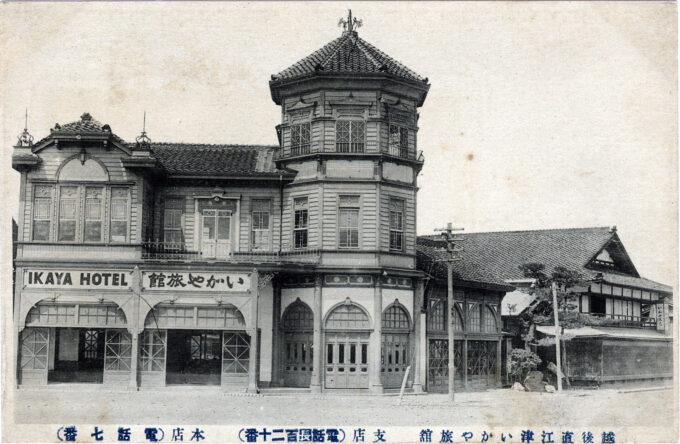
Ikaya Ryokan, Naoetsu, Niigata Prefecture, c. 1910. Ikaya ryokan first opened in 1872 twenty-five years before Naoetsu became the terminus of the Shin-etsu Line to Nagano. The building pictured, similar in appearance to the colonial Russian architecture of Sitka, Alaska, was completed in 1908 and remained standing and in operation until 1980. The ryokan also was a food vendor at the train station, selling one of the first eki-ben created [a boxed ‘station meal’] in 1901 and sold to those waiting within the station and to in-transit passengers vended from platform kiosks.
See also:
“Ski”, Takada (Joetsu), Japan, c. 1915.
Naraya Hotel (Ryokan), Hakone, c. 1910.
Menoyu Ryokan, Asama hot springs, Matsumoto, c. 1930.
Naoetsu was an important port on the Sea of Japan during the Kamakura period (1192–1333). It experienced a decline in the early 1600s and was known merely as an outport for the more-prosperous city of Takada. The arrival of two railway lines in 1898 and 1914 revived the port, and Naoetsu rapidly industrialized.
Under terms of the Ansei Treaty of 1859, Niigata became one of just five Japanese ports opened to foreign trade — predominately Russian until the turn of the century.
Entering the Meiji era, Naoetsu became a popular port of call for regular coastal travel to Niigata and Otaru, and on key transport routes over the Sea of Japan from northwest Japan to the Kobe outport of Maizu. In addition, the Shin-Etsu Line railway opened in the direction of Nagano from Naoetsu in 1886, making it the only railway for many years to reach central Japan from the northern coast.
The distribution of goods could now more easily go beyond the Nagano area, and factories advanced into the hinterland.

